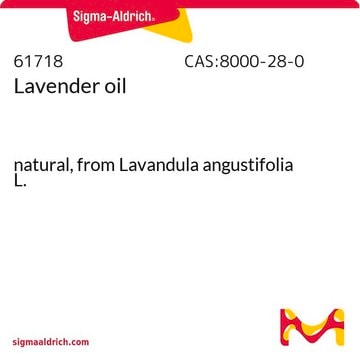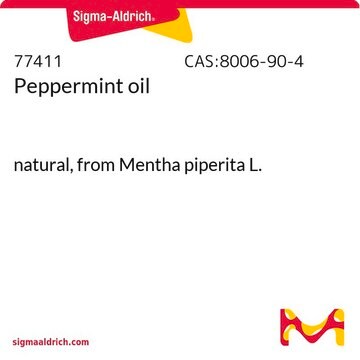W299200
Rosemary oil
FG
Sinónimos:
Rosmarinus officinalis
About This Item
Productos recomendados
origen biológico
Rosemarinus officinalis L.
Nivel de calidad
300
400
grado
FG
Halal
Kosher
cumplimiento norm.
EU Regulation 1334/2008 & 872/2012
FDA 21 CFR 182.20
actividad óptica
[α]20/D +1.2°, neat
índice de refracción
n20/D 1.467
bp
176 °C
densidad
0.908 g/mL at 25 °C
aplicaciones
flavors and fragrances
Documentación
see Safety & Documentation for available documents
alérgeno alimentario
no known allergens
Organoléptico
herbaceous; balsamic
¿Está buscando productos similares? Visita Guía de comparación de productos
Palabra de señalización
Warning
Frases de peligro
Consejos de prudencia
Clasificaciones de peligro
Eye Irrit. 2 - Flam. Liq. 3 - Skin Irrit. 2 - STOT SE 3
Órganos de actuación
Respiratory system
Código de clase de almacenamiento
3 - Flammable liquids
Clase de riesgo para el agua (WGK)
WGK 2
Punto de inflamabilidad (°F)
120.2 °F - closed cup
Punto de inflamabilidad (°C)
49 °C - closed cup
Equipo de protección personal
Eyeshields, Faceshields, Gloves, type ABEK (EN14387) respirator filter
Elija entre una de las versiones más recientes:
¿Ya tiene este producto?
Encuentre la documentación para los productos que ha comprado recientemente en la Biblioteca de documentos.
Nuestro equipo de científicos tiene experiencia en todas las áreas de investigación: Ciencias de la vida, Ciencia de los materiales, Síntesis química, Cromatografía, Analítica y muchas otras.
Póngase en contacto con el Servicio técnico





